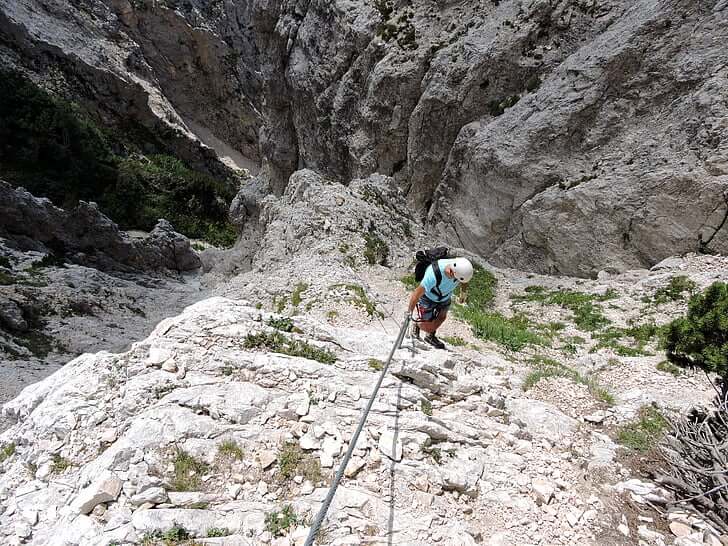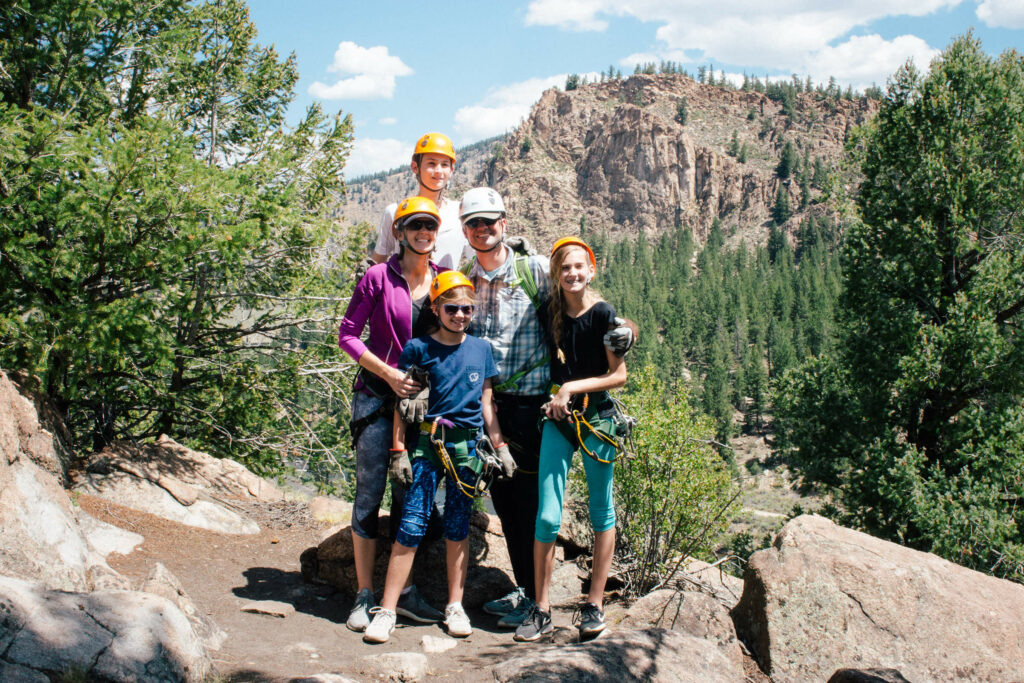One of the great things about a Via Ferrata course is that it makes technical climbs more accessible, allowing people of varying levels to experience more intricate or advanced climbing routes. These routes consist of a system of ladders, rungs, cables, and bridges fixed to the rock, providing adventurers with a means to ascend challenging terrain.
As a way to ensure safety and help climbers choose routes that match their skills, several different Via Ferrata rating systems have emerged. In this blog, we will delve into the Schall Rating System, one of the most commonly used Via Ferrata rating methods, providing insight into how routes are classified and how adventurers make informed choices about their next Via Ferrata experience.
Components of the Schall Rating Scale
The Schall Rating scale, developed by Andreas Schall, is a simpler classification system used to rate Via Ferrata routes, based primarily on the overall difficulty of a Via Ferrata route. This overall difficulty takes into account various factors that climbers will encounter during their ascent. While it is a simplified system compared to some other rating scales, the overall difficulty rating reflects the combination of several key elements:
- Physical Demands: The physical challenges associated with a route are a significant component of its overall difficulty. Longer, steeper, and more strenuous routes are assigned higher numerical grades.
- Technical Difficulty: The technical skills required to navigate a Via Ferrata route are another important aspect. Routes with complex and physically demanding sections, intricate features, or advanced climbing techniques may receive higher grades.
- Exposure and Terrain: Exposure refers to the amount of open space or risk that climbers face during the ascent. Routes with higher exposure can be mentally challenging, especially for individuals with a fear of heights. Routes with substantial exposure often receive higher numerical grades.
- Environmental Factors: The environmental conditions of a route, such as weather and rock quality, are considered when determining the overall difficulty. Routes that are more susceptible to weather-related challenges or have less stable rock may receive higher grades.
The Schall Rating Scale primarily focuses on providing an overall difficulty rating for each route, utilizing a single letter grade to represent this overall difficulty:
Letter Grades:
A (Beginner): Suitable for beginners and families. These routes are relatively easy, with plenty of safety features and little exposure.
B (Intermediate): Designed for those with some Via Ferrata experience. Routes may have more challenging sections with increased exposure.
C (Advanced): Reserved for experienced climbers. Expect long and challenging routes with steep and exposed sections.
D (Difficult): Reserved for expert climbers. These routes feature physically demanding sections and significant exposure.
E (Extreme): The most difficult. Requires extreme skill, strength, and mental stamina.
Interpreting Via Ferrata Ratings
To make informed choices about your Via Ferrata adventure using the Schall Rating Scale, consider the following factors:
- Know Your Skill Level: Be honest about your skills and experience. If you are a beginner, start with routes rated A or B. Intermediate climbers can consider routes rated C, while experienced and advanced climbers may tackle routes rated D or E.
- Evaluate Physical Fitness: Longer, more strenuous routes demand better endurance and strength. Choose routes that match your physical fitness level and gradually progress to more challenging ones.
- Comfort with Exposure: Your comfort level with heights and exposure is crucial. If you are not at ease with substantial exposure, it’s wise to begin with lower-rated routes and work your way up as your confidence grows.
- Be Prepared with Equipment: Different routes may require specialized gear or equipment. Ensure you have the necessary equipment, such as a Via Ferrata lanyard with a shock absorber, harness, helmet, and gloves, as per the route’s requirements.
- Local Advice: Local experts or guides can provide valuable insights into the specific conditions and challenges of a route. Seek their advice and recommendations, especially when exploring unfamiliar areas.
Via Ferrata routes provide an exciting way to experience the thrill of rock climbing in a safe and controlled environment. The Via Ferrata rating system plays a vital role in ensuring that climbers choose routes that match their skills, experience, and comfort levels. By understanding the letter and numerical grades, considering factors such as physical difficulty, technical difficulty, exposure, and equipment requirements, and seeking local advice, you can plan a Via Ferrata adventure that’s both exhilarating and safe.
Guided Via Ferrata courses offer the opportunity to experience the best of these climbing routes, led by highly trained guides who know the route better than anyone. They’ll show you how to use all necessary equipment, helping you stay safe on the course and have fun. Our guides are also always excited about sharing their love of Colorado’s mountains and outdoor adventure with our guests, making the adventure even more memorable.
















